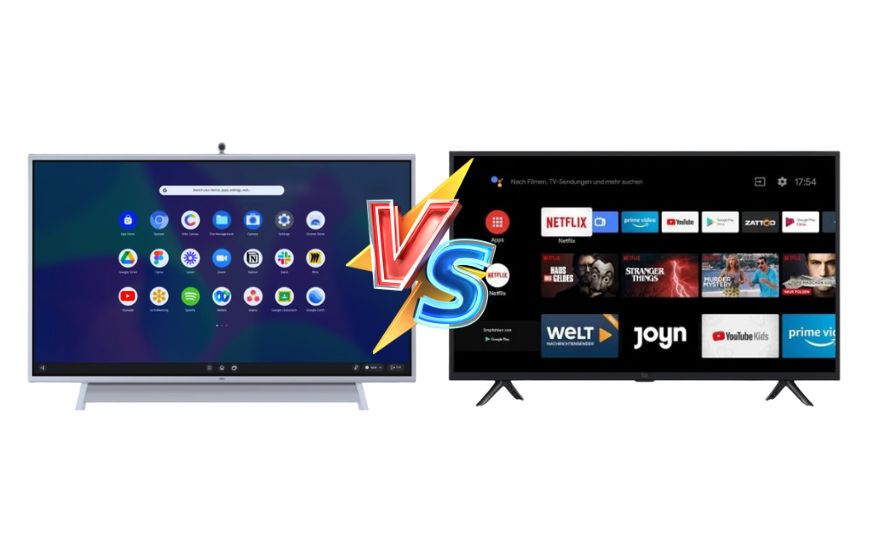As an Amazon Associate, I earn from qualifying purchases.
Smartboard VS Smart TV Comparison In the ever-evolving technology landscape, options have become accessible to consumers, particularly regarding interactive display solutions. Two famous alternatives that often locate themselves in evaluation are Smartboards and Smart TVs. Both serve distinct purposes, but perceiving their features, functionalities, and functions is essential for making an informed decision. In this complete guide, we will delve into the intricacies of Smartboards and Smart TVs, imparting a particular contrast to assist you in deciding which alternative aligns higher with your needs.
Purpose and Functionality: Smartboard VS Smart TV

Smartboards:
Additionally recognized as interactive whiteboards, smartboards are designed chiefly for collaborative and interactive studying or commercial enterprise presentations. They allow customers to interact with digital content through contact or stylus input. Smartboards are broadly used in instructional settings to enhance classroom engagement and in company environments for dynamic presentations.
Smart TVs:
Smart TVs, on the other hand, are designed for home entertainment. They combine usual TV aspects with web connectivity, enabling users to circulate content, browse the web, and get the right of entry to several applications. While they offer some interactive features, their foremost focal point is turning into a seamless leisure experience.
Display Technology: Smartboard VS Smart TV
Smartboards:
Smartboards use advanced touch-sensitive technologies such as infrared, electromagnetic, or capacitive touch to detect input. The show is frequently interactive and responds to touch, gestures, and stylus input. The performance varies satisfactorily, with picks ranging from widespread HD to 4K resolution, presenting a clear, crisp, visible experience.
Smart TVs:
Smart TVs use several technologies, including LED, OLED, QLED, and more. The emphasis is on turning in amazing visuals for an immersive entertainment experience. Resolution choices vary from HD to 8K, presenting first-rate clarity for watching movies and TV shows and participating in games.
Connectivity: Smartboard VS Smart TV
Smartboards:
Connectivity is a crucial aspect of Smartboards, facilitating collaboration and integration with different devices. They often come outfitted with multiple HDMI, USB, and VGA ports, permitting seamless connections to computers, tablets, and other peripherals. Wireless connectivity alternatives like Bluetooth and Wi-Fi are additionally common.
Smart TVs:
Smart TVs prioritize wireless connectivity, with built-in Wi-Fi and Bluetooth capabilities. They are designed to join the net to stream content from several online platforms. Additionally, Smart TVs have multiple HDMI and USB ports to accommodate external gadgets like gaming consoles, Blu-ray players, and sound systems.
User Interface and Software: Smartboard VS Smart TV

Smartboards:
The personal interface of Smartboards is tailored for interactive collaboration. Their specialized software program allows users to draw, annotate, and manipulate digital content. Educational Smartboards frequently consist of educational tools, while business-oriented ones offer points for dynamic presentations.
Smart TVs:
Smart TVs feature accessible interfaces that are optimized for navigation and the use of a far-off control. The operating structures differ among manufacturers, with popular ones being Android TV, webOS, and Tizen. Smart TVs additionally have to get entry to application stores, allowing users to download and install more than a few enjoyment apps.
Accessibility and Usability: Smartboard VS Smart TV
Smartboards:
Smartboards promote inclusivity and engagement in instructional environments. They cater to various studying patterns and abilities, supplying an interactive platform for students. Accessibility features such as voice commands and display screen readers may also be built into the software program to accommodate customers with numerous needs.
Smart TVs:
Smart TVs prioritize ease of use for home entertainment. The user interface is planned to be intuitive, permitting users to navigate through menus and apps without difficulty using a far-off control. While some accessibility elements may be available, they may not be as sizeable as those observed in Smartboards.
Cost Considerations: Smartboard VS Smart TV
Smartboards:
Smartboards are steeply-priced due to their specialized interactive aspects and superior touch technologies. The price may include extra add-ons like interactive pens and software program licenses. However, the investment is justified by their more vital collaboration and presentation abilities.
Smart TVs:
Smart TVs come in a broad price range, supplying selections to match several budgets. The cost is influenced by brand, display technology, and display size. While they may not have the same stage of interactivity as Smartboards, they provide magnificent fees for home entertainment.
Conclusion:
In the Smartboard vs. Smart TV comparison, the preference relies upon your unique wants and use case. A Smartboard is the ideal choice if you are looking for a collaborative and interactive solution for training or enterprise presentations. On the other hand, if your important focus is on domestic amusement with the convenience of net connectivity and app access, a Smart TV is the way to go.
Understanding the unique features, functionalities, and considerations of each smartboard and Smart TV is critical for making an informed decision. Considering the pros and cons in this guide, you can confidently select the technology that aligns with your necessities and enhances your standard experience. Whether you’re transforming how you teach, present, or entertain, the right desire between Smartboards and Smart TVs can greatly impact your everyday activities.
FAQs
What is the essential motive of a Smartboard?
A Smartboard, regarded as an interactive whiteboard, is designed for collaborative mastering and dynamic presentations. It allows users to participate in digital content using touch or stylus input, bettering engagement in instructional and enterprise settings.
How does a Smart TV vary from an everyday TV?
A Smart TV goes beyond standard television by incorporating web connectivity. It enables customers to stream content, browse the web, and access various functions directly on the TV screen. Smart TVs provide an excellent interactive and related leisure experience, unlike ordinary TVs.
Can I join external gadgets to a Smartboard?
Yes, Smartboards are equipped with a couple of connectivity options. Using HDMI, USB, or ports, you can connect external devices such as computers, tablets, and peripherals. Some Smartboards also help Wi-Fi connections, making collaboration seamless.
Are Smart TVs solely for streaming content?
While streaming content is a tremendous feature of Smart TVs, they are versatile devices. Smart TVs aid various apps, including games, news, and productivity tools. Additionally, they have more than one port for connecting gaming consoles, Blu-ray players, and different exterior devices.
What are the critical differences between Smartboards and Smart TVs?
Smartboards are interactive whiteboards designed for collaborative mastering and presentations, presenting touch or stylus input. Smart TVs, on the other hand, are targeted at domestic entertainment, presenting web connectivity for streaming content and having access to apps. The preference depends on your particular wants – interactive collaboration or immersive entertainment.
Amazon and the Amazon logo are trademarks of Amazon.com, Inc, or its affiliates.